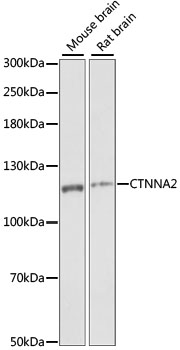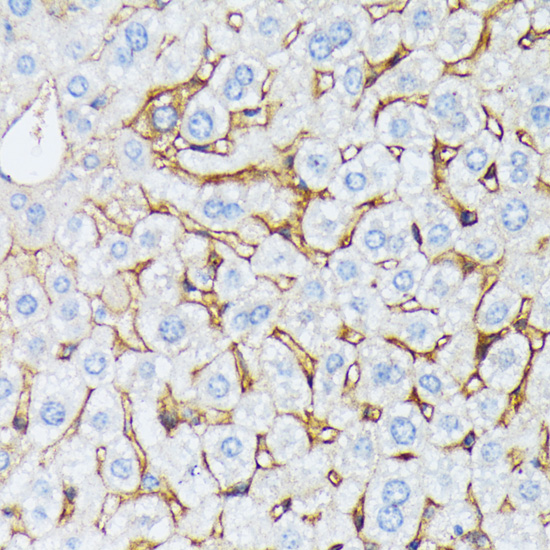Anti-CTNNA2 Antibody (CAB15269)
- SKU:
- CAB15269
- Product type:
- Antibody
- Reactivity:
- Mouse
- Reactivity:
- Rat
- Host Species:
- Rabbit
- Isotype:
- IgG
- Antibody Type:
- Polyclonal Antibody
- Research Area:
- Cell Biology
Description
| 抗体名: | Anti-CTNNA2 Antibody |
| 抗体コード: | CAB15269 |
| 抗体サイズ: | 20uL, 50uL, 100uL |
| 申し込み: | WB IHC |
| 反応性: | Mouse, Rat |
| 宿主種: | Rabbit |
| 免疫原: | Recombinant fusion protein containing a sequence corresponding to amino acids 150-300 of human CTNNA2 (NP_004380.2). |
| 申し込み: | WB IHC |
| 推奨希釈: | WB 1:200 - 1:2000 IHC 1:50 - 1:200 |
| 反応性: | Mouse, Rat |
| ポジティブサンプル: | Mouse brain, Rat brain |
| 免疫原: | Recombinant fusion protein containing a sequence corresponding to amino acids 150-300 of human CTNNA2 (NP_004380.2). |
| 精製方法: | Affinity purification |
| ストレージバッファ: | Store at -20'C. Avoid freeze / thaw cycles. Buffer: PBS with 0.02% sodium azide, 50% glycerol, pH7.3. |
| アイソタイプ: | IgG |
| 順序: | LSHL KIVE EALE AVKN ATNE QDLA NRFK EFGK EMVK LNYV AARR QQEL KDPH CRDE MAAA RGAL KKNA TMLY TASQ AFLR HPDV AATR ANRD YVFK QVQE AIAG ISNA AQAT SPTD EAKG HTGI GELA AALN EFDN KIIL DPMT FSEA RFR |
| 遺伝子ID: | 1496 |
| Uniprot: | P26232 |
| セルラーロケーション: | Cell junction, Cell membrane, Cell projection, Cytoplasm, Cytoplasmic side, Peripheral membrane protein, adherens junction, axon, cytoskeleton |
| 計算された分子量: | 59kDa/65kDa/95kDa/100kDa/104kDa/105kDa |
| 観察された分子量: | 120kDa |
| 同義語: | CTNNA2, CAP-R, CAPR, CT114, CTNR |
| バックグラウンド: |
| UniProt Protein Function: | CTNNA1: Associates with the cytoplasmic domain of a variety of cadherins. The association of catenins to cadherins produces a complex which is linked to the actin filament network, and which seems to be of primary importance for cadherins cell-adhesion properties. Can associate with both E- and N-cadherins. Originally believed to be a stable component of E-cadherin/catenin adhesion complexes and to mediate the linkage of cadherins to the actin cytoskeleton at adherens junctions. In contrast, cortical actin was found to be much more dynamic than E-cadherin/catenin complexes and CTNNA1 was shown not to bind to F-actin when assembled in the complex suggesting a different linkage between actin and adherens junctions components. The homodimeric form may regulate actin filament assembly and inhibit actin branching by competing with the Arp2/3 complex for binding to actin filaments. May play a crucial role in cell differentiation. Monomer and homodimer; the monomer preferentially binds to CTNNB1 and the homodimer to actin. Binds MLLT4 and F-actin. Possible component of an E-cadherin/ catenin adhesion complex together with E-cadherin/CDH1 and beta-catenin/CTNNB1 or gamma- catenin/JUP; the complex is located to adherens junctions. The stable association of CTNNA1 is controversial as CTNNA1 was shown not to bind to F-actin when assembled in the complex. Alternatively, the CTNNA1-containing complex may be linked to F- actin by other proteins such as LIMA1. Interacts with ARHGAP21 and with AJUBA. Interacts with LIMA1. Expressed ubiquitously in normal tissues. Belongs to the vinculin/alpha-catenin family. 2 isoforms of the human protein are produced by alternative splicing. |
| UniProt Protein Details: | Protein type:Motility/polarity/chemotaxis; Actin-binding Chromosomal Location of Human Ortholog: 5q31.2 Cellular Component: focal adhesion; lamellipodium; acrosome; plasma membrane; intercellular junction; zonula adherens; catenin complex; cytosol; actin cytoskeleton Molecular Function:actin filament binding; protein binding; cadherin binding; gamma-catenin binding; beta-catenin binding; structural molecule activity; vinculin binding Biological Process: intercellular junction assembly and maintenance; apical junction assembly; gap junction assembly; protein heterooligomerization; axon regeneration; male gonad development; establishment and/or maintenance of cell polarity; actin filament organization; odontogenesis of dentine-containing teeth; muscle cell differentiation; ovarian follicle development; negative regulation of neuroblast proliferation; response to estrogen stimulus; positive regulation of muscle cell differentiation; positive regulation of smoothened signaling pathway; cell adhesion; vascular endothelial growth factor receptor signaling pathway; aging |
| NCBI Summary: | This gene encodes a member of the catenin family of proteins that play an important role in cell adhesion process by connecting cadherins located on the plasma membrane to the actin filaments inside the cell. The encoded mechanosensing protein contains three vinculin homology domains and undergoes conformational changes in response to cytoskeletal tension, resulting in the reconfiguration of cadherin-actin filament connections. Certain mutations in this gene cause butterfly-shaped pigment dystrophy. [provided by RefSeq, May 2016] |
| UniProt Code: | P26232 |
| NCBI GenInfo Identifier: | 55770844 |
| NCBI Gene ID: | 1495 |
| NCBI Accession: | NP_001894.2 |
| UniProt Secondary Accession: | P26232,P26232, |
| UniProt Related Accession: | P35221 |
| Molecular Weight: | ~ 100kDa |
| NCBI Full Name: | catenin alpha-1 isoform 1 |
| NCBI Synonym Full Names: | catenin alpha 1 |
| NCBI Official Symbol: | CTNNA1 |
| NCBI Official Synonym Symbols: | MDPT2; CAP102 |
| NCBI Protein Information: | catenin alpha-1 |
| UniProt Protein Name: | Catenin alpha-1 |
| UniProt Synonym Protein Names: | Alpha E-catenin; Cadherin-associated protein; Renal carcinoma antigen NY-REN-13 |
| UniProt Gene Name: | CTNNA1 |
| UniProt Entry Name: | CTNA1_HUMAN |





